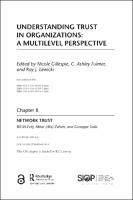Chapter 8 Network Trust
Proposal review
| dc.contributor.author | McEvily, Bill | |
| dc.contributor.author | Zaheer, Akbar | |
| dc.contributor.author | SODA, Giuseppe | |
| dc.date.accessioned | 2021-05-06T09:13:31Z | |
| dc.date.available | 2021-05-06T09:13:31Z | |
| dc.date.issued | 2021 | |
| dc.identifier.uri | https://library.oapen.org/handle/20.500.12657/48503 | |
| dc.description.abstract | In this chapter we aim to move beyond the extensive focus on relational trust in the organizational literature by broadening the conceptualization of trust to include its inherent generalizability across a network. Specifically, we introduce the concept of network trust. Central to our conceptualization is the idea that apart from forming as a result of direct interaction, trust also flows through the indirect connections linking individuals to one another and emerges from the inherent design features of the network itself. We further conceptualize network trust as comprised of two forms: second-hand trust and prototrust. Secondhand trust refers to the partial spillover of relational trust to socially proximate, indirectly connected actors. Prototrust refers to the latent potential for confident positive expectations to emerge between two actors who are neither directly nor indirectly connected. Drawing on network theory, we articulate the logics (in terms of mechanisms, indicators, and contingencies) by which secondhand trust and prototrust operate. We conclude with a call to treat network trust as a novel form and with an agenda for considering the unique understandings that network trust permits. | en_US |
| dc.language | English | en_US |
| dc.subject.classification | bic Book Industry Communication::K Economics, finance, business & management::KJ Business & management::KJM Management & management techniques::KJMV Management of specific areas::KJMV2 Personnel & human resources management | en_US |
| dc.subject.classification | bic Book Industry Communication::K Economics, finance, business & management::KJ Business & management::KJU Organizational theory & behaviour | en_US |
| dc.subject.classification | bic Book Industry Communication::J Society & social sciences::JM Psychology | en_US |
| dc.subject.classification | bic Book Industry Communication::J Society & social sciences::JM Psychology::JMJ Occupational & industrial psychology | en_US |
| dc.subject.classification | thema EDItEUR::K Economics, Finance, Business and Management::KJ Business and Management::KJM Management and management techniques::KJMV Management of specific areas::KJMV2 Personnel and human resources management | en_US |
| dc.subject.classification | thema EDItEUR::K Economics, Finance, Business and Management::KJ Business and Management::KJU Organizational theory and behaviour | en_US |
| dc.subject.classification | thema EDItEUR::J Society and Social Sciences::JM Psychology | en_US |
| dc.subject.classification | thema EDItEUR::J Society and Social Sciences::JM Psychology::JMJ Occupational and industrial psychology | en_US |
| dc.subject.other | network trust, trust, second-hand trust, prototrust, relational trust, network theory, mechanism, indicators, contingencies, tie strength, social distance, network closure, vertical network differentiation, governance veracity, identity authenticity, swift trust | en_US |
| dc.title | Chapter 8 Network Trust | en_US |
| dc.type | chapter | |
| oapen.identifier.doi | 10.4324/9780429449185-8 | en_US |
| oapen.relation.isPublishedBy | 7b3c7b10-5b1e-40b3-860e-c6dd5197f0bb | en_US |
| oapen.relation.isPartOfBook | a103cbd6-0bae-4e4c-a58f-637b75d3b4ab | en_US |
| oapen.relation.isFundedBy | 608fbdcb-bd0a-4d50-9a26-902224692f76 | en_US |
| oapen.relation.isbn | 9781138327580 | en_US |
| oapen.relation.isbn | 9781138327597 | en_US |
| oapen.imprint | Routledge | en_US |
| oapen.pages | 27 | en_US |
| peerreview.anonymity | Single-anonymised | |
| peerreview.id | bc80075c-96cc-4740-a9f3-a234bc2598f1 | |
| peerreview.open.review | No | |
| peerreview.publish.responsibility | Publisher | |
| peerreview.review.stage | Pre-publication | |
| peerreview.review.type | Proposal | |
| peerreview.reviewer.type | Internal editor | |
| peerreview.reviewer.type | External peer reviewer | |
| peerreview.title | Proposal review | |
| oapen.review.comments | Taylor & Francis open access titles are reviewed as a minimum at proposal stage by at least two external peer reviewers and an internal editor (additional reviews may be sought and additional content reviewed as required). |

